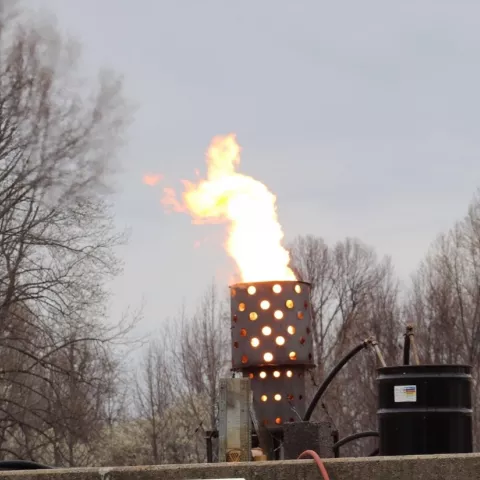You are viewing ARCHIVED content published online before Jan. 20, 2025. Please note that this content is NOT UPDATED,
and links may not work. Additionally, any previously issued diversity, equity, inclusion or gender-related guidance on
this webpage should be considered rescinded. For current information, visit
News Items | Bureau of Safety and Environmental Enforcement.

WASHINGTON – To inform oil spill responders about new technologies available to address oil spills, the Bureau of Safety and Environmental Enforcement and the U.S. Naval Research Laboratory (NRL) hosted an outdoor demonstration of the Low-Emission Spray Crude Oil Combustor technology–also known as the “BSEE Burner”–at NRL’s testing facility in Chesapeake Beach, Maryland, on March 30.
“This technology has the potential to be a game changer in the performance of oil spill recovery,” said BSEE Director Kevin Sligh. “I’ve seen how much damage an oil spill can cause, and the BSEE Burner, once deployed, will be an important tool to use in its mitigation.”
Developed in partnership with NRL over seven years, the BSEE Burner technology cleanly burns large volumes of emulsified oil from spills that occur in remote areas where storage facilities may not be available, or where transporting the recovered oil is cost prohibitive.
EPA emission tests revealed that the burner performs well with a combustion efficiency of 99.9%. Carbon monoxide concentrations were at almost undetectable levels, and low soot emissions yielded no visible smoke plume.
“This technology can completely burn oil without the plume of harmful black smoke or residue,” said Steven Tuttle, Ph.D., NRL combustion and reacting transport section head and developer and operator of the burner. “This burner will benefit the environment by providing oil spill remediation of emulsified crude oil in remote locations, where the carbon footprint of transporting the oil to be re-processed is greater than burning the oil in place.”
Attended by the U.S. Coast Guard, NOAA, industry, and oil spill response organizations, BSEE and NRL arranged the demonstration to facilitate open discussions regarding potential use scenarios and system specifications, and for those who may have an interest in pursuing licensing options and licensing information with the U.S. Navy.
The invention is another important example of Federal technology transfer efforts and is now ready for commercialization by private interests through collaboration with TechLink – a nationally focused technology transfer partnership intermediary for the U.S. Department of Defense and Department of Veterans Affairs.
BSEE conducts research and development as part of its robust Oil Spill Preparedness Program. The program ensure owners and operators of offshore facilities are ready to respond to threats of and actual oil spills that may result from their activities. These research efforts benefit oil spill responders and contingency planners by providing expanded decision-making options, better tactics, and updated equipment.
-BSEE-
